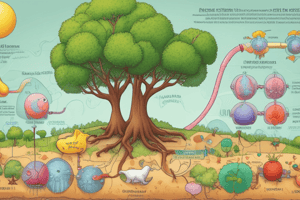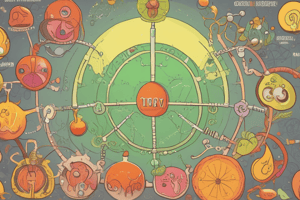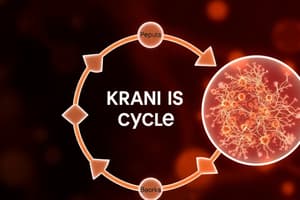Podcast
Questions and Answers
What is the primary role of the hydrophobic pocket in the citrate synthase reaction?
What is the primary role of the hydrophobic pocket in the citrate synthase reaction?
- To provide a binding site for the iron-sulfur cluster.
- To protect the AcCoA anion from hydrolysis. (correct)
- To facilitate the binding of NADH.
- To promote the oxidation of citrate.
Why does aconitase isomerize citrate to isocitrate?
Why does aconitase isomerize citrate to isocitrate?
- Citrate is a tertiary alcohol and thus a poor substrate for oxidation. (correct)
- Citrate inhibits downstream enzymes if not modified.
- Isocitrate is more easily transported across the mitochondrial membrane.
- Citrate is too easily oxidized, potentially leading to uncontrolled reactions.
What is the significance of aconitase removing the pro-R hydrogen from the pro-R arm of citrate?
What is the significance of aconitase removing the pro-R hydrogen from the pro-R arm of citrate?
- It ensures the reaction proceeds with the correct stereochemistry. (correct)
- It activates the iron-sulfur cluster.
- It facilitates the binding of CoA.
- It prevents the formation of fluorocitrate.
How does fluoroacetate indirectly inhibit the TCA cycle?
How does fluoroacetate indirectly inhibit the TCA cycle?
What role does the iron-sulfur cluster play in the aconitase reaction?
What role does the iron-sulfur cluster play in the aconitase reaction?
What is the role of the phosphohistidine intermediate in the succinyl-CoA synthetase reaction?
What is the role of the phosphohistidine intermediate in the succinyl-CoA synthetase reaction?
Which type of reaction is catalyzed by succinate dehydrogenase in the TCA cycle?
Which type of reaction is catalyzed by succinate dehydrogenase in the TCA cycle?
During the oxidation of succinate to oxaloacetate, how many times will a process that involves oxidation of a C-C single bond to a double bond be seen throughout the text?
During the oxidation of succinate to oxaloacetate, how many times will a process that involves oxidation of a C-C single bond to a double bond be seen throughout the text?
Succinate dehydrogenase differs from other enzymes in the citric acid cycle because it:
Succinate dehydrogenase differs from other enzymes in the citric acid cycle because it:
What is the direct role of FAD in the succinate dehydrogenase reaction?
What is the direct role of FAD in the succinate dehydrogenase reaction?
What is the immediate fate of the NADH produced by isocitrate dehydrogenase?
What is the immediate fate of the NADH produced by isocitrate dehydrogenase?
Which of the following statements accurately describes the role of ADP in the isocitrate dehydrogenase reaction?
Which of the following statements accurately describes the role of ADP in the isocitrate dehydrogenase reaction?
During the isocitrate dehydrogenase reaction, which specific type of chemical reaction leads to the release of $CO_2$?
During the isocitrate dehydrogenase reaction, which specific type of chemical reaction leads to the release of $CO_2$?
Isocitrate dehydrogenase is subject to allosteric regulation. Which of the following options correctly identifies its allosteric regulators?
Isocitrate dehydrogenase is subject to allosteric regulation. Which of the following options correctly identifies its allosteric regulators?
How does the $\alpha$-ketoglutarate dehydrogenase complex resemble the pyruvate dehydrogenase complex?
How does the $\alpha$-ketoglutarate dehydrogenase complex resemble the pyruvate dehydrogenase complex?
What is the correct order of events in the conversion of isocitrate to $\alpha$-ketoglutarate?
What is the correct order of events in the conversion of isocitrate to $\alpha$-ketoglutarate?
In addition to energy production, what other significant metabolic role does $\alpha$-ketoglutarate play?
In addition to energy production, what other significant metabolic role does $\alpha$-ketoglutarate play?
Which coenzyme is NOT directly involved in the activity of the $\alpha$-ketoglutarate dehydrogenase complex?
Which coenzyme is NOT directly involved in the activity of the $\alpha$-ketoglutarate dehydrogenase complex?
Which statement accurately describes the role of malate dehydrogenase in the citric acid cycle?
Which statement accurately describes the role of malate dehydrogenase in the citric acid cycle?
Why is the concentration of oxaloacetate kept very low in the mitochondrial matrix?
Why is the concentration of oxaloacetate kept very low in the mitochondrial matrix?
What is the net production of reduced coenzymes (NADH and FADH2) from one turn of the TCA cycle?
What is the net production of reduced coenzymes (NADH and FADH2) from one turn of the TCA cycle?
In which turn of the TCA cycle is the carbonyl carbon of acetyl-CoA released as $CO_2$?
In which turn of the TCA cycle is the carbonyl carbon of acetyl-CoA released as $CO_2$?
What is the approximate net free energy change ($\Delta Gº'$) for one complete turn of the TCA cycle?
What is the approximate net free energy change ($\Delta Gº'$) for one complete turn of the TCA cycle?
Which of the following best describes the stereochemistry of fumarase's hydration reaction?
Which of the following best describes the stereochemistry of fumarase's hydration reaction?
What is the ultimate fate of the methyl carbon of acetyl-CoA after it enters the TCA cycle?
What is the ultimate fate of the methyl carbon of acetyl-CoA after it enters the TCA cycle?
Besides $CO_2$, how many other products are directly generated during one turn of the TCA cycle from one molecule of acetyl-CoA?
Besides $CO_2$, how many other products are directly generated during one turn of the TCA cycle from one molecule of acetyl-CoA?
Why can't the direct cleavage between carbons α- and β- to a carbonyl be used for acetate?
Why can't the direct cleavage between carbons α- and β- to a carbonyl be used for acetate?
What is the primary reason a direct α-cleavage of acetate is not a favorable reaction?
What is the primary reason a direct α-cleavage of acetate is not a favorable reaction?
How does the TCA cycle overcome the limitations of directly cleaving acetate?
How does the TCA cycle overcome the limitations of directly cleaving acetate?
What is the overall outcome of the combined cleavage and oxidation reactions in the TCA cycle?
What is the overall outcome of the combined cleavage and oxidation reactions in the TCA cycle?
Which of the following statements best describes the role of the reductive TCA cycle in certain archaea and bacteria?
Which of the following statements best describes the role of the reductive TCA cycle in certain archaea and bacteria?
Where does the formation of acetyl-CoA from pyruvate primarily occur?
Where does the formation of acetyl-CoA from pyruvate primarily occur?
What is the proposed original energy source that may have driven the reductive TCA cycle?
What is the proposed original energy source that may have driven the reductive TCA cycle?
Citrate synthase is inhibited by ATP, NADH, and succinyl-CoA. What type of metabolic control does this represent?
Citrate synthase is inhibited by ATP, NADH, and succinyl-CoA. What type of metabolic control does this represent?
Besides pyruvate oxidation, what are other sources of Acetyl-CoA in the cytosol?
Besides pyruvate oxidation, what are other sources of Acetyl-CoA in the cytosol?
Which of the following cofactors are required by pyruvate dehydrogenase?
Which of the following cofactors are required by pyruvate dehydrogenase?
How does phosphorylation affect the activity of pyruvate dehydrogenase?
How does phosphorylation affect the activity of pyruvate dehydrogenase?
How does the citrate synthase reaction contribute to driving the TCA cycle forward, given its near-equilibrium constant ($K_{eq} \approx 1$)?
How does the citrate synthase reaction contribute to driving the TCA cycle forward, given its near-equilibrium constant ($K_{eq} \approx 1$)?
What is the primary benefit of the TCA cycle enzymes forming a metabolon?
What is the primary benefit of the TCA cycle enzymes forming a metabolon?
What structural feature of the TCA cycle metabolon facilitates the transport of substrates between enzymes?
What structural feature of the TCA cycle metabolon facilitates the transport of substrates between enzymes?
Why can't the TCA cycle alone support net synthesis of carbohydrates from acetate?
Why can't the TCA cycle alone support net synthesis of carbohydrates from acetate?
Which two enzymes are unique to the glyoxylate cycle, allowing certain organisms to utilize acetate as their sole carbon source?
Which two enzymes are unique to the glyoxylate cycle, allowing certain organisms to utilize acetate as their sole carbon source?
Flashcards
Citrate Synthase Function
Citrate Synthase Function
Citrate synthase reaction initiates the TCA cycle by catalyzing the condensation of oxaloacetate and acetyl-CoA to form citrate.
Aconitase Role
Aconitase Role
Aconitase catalyzes the isomerization of citrate to isocitrate, converting a tertiary alcohol to a secondary alcohol for oxidation.
Aconitase Stereospecificity
Aconitase Stereospecificity
Aconitase stereospecifically removes the pro-R hydrogen from the pro-R arm of citrate during isomerization.
Aconitase's Iron-Sulfur Cluster
Aconitase's Iron-Sulfur Cluster
Signup and view all the flashcards
Fluoroacetate's Poisonous Effect
Fluoroacetate's Poisonous Effect
Signup and view all the flashcards
α,β-Carbonyl Cleavage
α,β-Carbonyl Cleavage
Signup and view all the flashcards
α,β-Carbonyl Cleavage in Glycolysis
α,β-Carbonyl Cleavage in Glycolysis
Signup and view all the flashcards
TCA Cycle Strategy
TCA Cycle Strategy
Signup and view all the flashcards
Pyruvate Dehydrogenase (PDH)
Pyruvate Dehydrogenase (PDH)
Signup and view all the flashcards
PDC Structure
PDC Structure
Signup and view all the flashcards
PDC Reaction Mechanism
PDC Reaction Mechanism
Signup and view all the flashcards
Citrate Synthase Reaction
Citrate Synthase Reaction
Signup and view all the flashcards
Succinyl-CoA Synthetase
Succinyl-CoA Synthetase
Signup and view all the flashcards
Succinyl-CoA Hydrolysis Role
Succinyl-CoA Hydrolysis Role
Signup and view all the flashcards
Succinyl-CoA Synthetase Mechanism
Succinyl-CoA Synthetase Mechanism
Signup and view all the flashcards
Three-Reaction Sequence in TCA Cycle
Three-Reaction Sequence in TCA Cycle
Signup and view all the flashcards
Succinate Dehydrogenase
Succinate Dehydrogenase
Signup and view all the flashcards
Isocitrate Dehydrogenase
Isocitrate Dehydrogenase
Signup and view all the flashcards
Isocitrate Dehydrogenase Mechanism
Isocitrate Dehydrogenase Mechanism
Signup and view all the flashcards
Isocitrate Dehydrogenase Regulation
Isocitrate Dehydrogenase Regulation
Signup and view all the flashcards
α-Ketoglutarate Dehydrogenase
α-Ketoglutarate Dehydrogenase
Signup and view all the flashcards
α-Ketoglutarate Dehydrogenase Coenzymes
α-Ketoglutarate Dehydrogenase Coenzymes
Signup and view all the flashcards
α-Ketoglutarate Dehydrogenase Complex
α-Ketoglutarate Dehydrogenase Complex
Signup and view all the flashcards
α-Ketoglutarate Dehydrogenase Reaction
α-Ketoglutarate Dehydrogenase Reaction
Signup and view all the flashcards
Enzymes in α-Ketoglutarate Dehydrogenase Complex
Enzymes in α-Ketoglutarate Dehydrogenase Complex
Signup and view all the flashcards
Fumarase
Fumarase
Signup and view all the flashcards
Malate Dehydrogenase
Malate Dehydrogenase
Signup and view all the flashcards
Oxaloacetate Concentration
Oxaloacetate Concentration
Signup and view all the flashcards
TCA Cycle Products (per turn)
TCA Cycle Products (per turn)
Signup and view all the flashcards
TCA Cycle ΔGº'
TCA Cycle ΔGº'
Signup and view all the flashcards
Glycolysis + TCA = ATP
Glycolysis + TCA = ATP
Signup and view all the flashcards
TCA Net Reaction
TCA Net Reaction
Signup and view all the flashcards
Fate of Carbonyl C
Fate of Carbonyl C
Signup and view all the flashcards
Reductive TCA Cycle
Reductive TCA Cycle
Signup and view all the flashcards
TCA Cycle Regulation
TCA Cycle Regulation
Signup and view all the flashcards
Citrate Synthase Inhibitors
Citrate Synthase Inhibitors
Signup and view all the flashcards
Isocitrate Dehydrogenase Regulators
Isocitrate Dehydrogenase Regulators
Signup and view all the flashcards
α-Ketoglutarate Dehydrogenase Regulators
α-Ketoglutarate Dehydrogenase Regulators
Signup and view all the flashcards
PDH Regulation
PDH Regulation
Signup and view all the flashcards
TCA Cycle Metabolon
TCA Cycle Metabolon
Signup and view all the flashcards
Glyoxylate Cycle
Glyoxylate Cycle
Signup and view all the flashcards
Study Notes
Chapter 19: The Tricarboxylic Acid Cycle
- Chapter 19 covers the Tricarboxylic Acid Cycle (TCA cycle).
- Important questions addressed are how pyruvate is oxidized under aerobic conditions and the chemical logic governing this process.
- The summary of the chapter covers the chemical logic, the oxidative decarboxylation of pyruvate to acetyl-CoA, CO2 production from acetyl-CoA, regeneration of oxaloacetate, the energetic consequences, intermediates for biosynthesis, anaplerotic reactions, and regulation of the cycle.
History of the TCA Cycle
- In 1932, Krebs discovered that small acids like succinic, fumaric, malic, citric, oxaloacetic, and acetic become oxidized in kidney and liver tissues.
- In 1935, Albert Szent-György found that 4-carbon acids in pigeon muscle leads to the consumption of more O2 is consumed than required by those acids alone.
- Scientists concluded that the addition of acid activated the burning of substances like glucose and adding enzyme inhibitors revealed crucial steps in oxidation.
- Martius and Knoop showed that citrate converts to isocitrate.
- Krebs showed that oxaloacetate becomes citrate in muscle tissue, postulating his 2nd cycle (urea cycle in 1932).
Glucose Oxidation
- The oxidation of glucose to CO2 is a 24-electron oxidation.
- Electrons derived from glucose oxidation feed into the electron transport pathway, which drives ATP synthesis.
- Pyruvate from glycolysis is oxidatively decarboxylated to acetate.
- Acetate then degrades to 2 CO2 in the cycle with some ATP produced and more NADH.
- NADH contributes to ATP production via electron transport and oxidative phosphorylation.
- The TCA cycle is also known as the Krebs cycle or the citric acid cycle.
Chemical Logic of the TCA Cycle
- The TCA cycle oxidizes acetate units to CO2. Oxidation of acetyl requires C-C cleavage.
- C-C bond cleavage generally includes cleavage between carbons α- and β- to a carbonyl or α-cleavage of an α-hydroxyketone. These cleavages aren't effective for acetyl-CoA.
- Condensing acetate with oxaloacetate allows for β-cleavage.
- This cleavage combines with oxidation to form CO2, regenerating oxaloacetate, capturing energy as NADH and ATP.
Entry into the TCA Cycle
- Pyruvate converts to acetyl-CoA only in mitochondria, but in the cytosol, AcCoA sources are from citrate or amino acid degradation, not pyruvate.
- Pyruvate dehydrogenase utilizes TPP, COASH, lipoic acid, FAD, and NAD+.
- Citrate synthase (CS) is classic CoA chemistry.
- NADH and succinyl-CoA are allosteric inhibitors.
Pyruvate Dehydrogenase
- Pyruvate Dehydrogenase is a 3 enzyme complex (PDC): 2 dehydrogenases and one transacylase.
- The complex includes PDH (pyruvate dehydrogenase), dihydrolipoyl transacetylase (TA), and dihydrolipoyl dehydrogenase (DLD).
- Pyruvate loses CO2 and gets converted into HETPP.
- A hydroxyethyl group transfers to lipoic acid and oxidizes to form acetyl dihydrolipoate.
- The acetyl group finally transfers to CoA, reoxidizing lipoic acid.
- Decarboxylation of pyruvate yields hydroxyethyl-TPP.
Reactions of the TCA Cycle
- Each reaction has a specific enzyme
Citrate Synthase
- Citrate synthase initiates the TCA cycle, forming citrate from oxaloacetate and acetyl-CoA via a nucleophilic attack.
- Hydrolysis of this thioester drives the reaction.
- Citrate synthase has a Keq1=1, but its large AG°=-31.4 KJ/mol, drives it and is basically irreversible.
- AcCoA anion is protected from H2O in an hydrophobic pocket.
- NADH is an allosteric inhibitor due to the large AG0.
- The enzyme in mammals is a dimer of 49-kD subunits, with active sites lying in a cleft between two domains, surrounded by α-helical segments
Aconitase
- Aconitase isomerizes citrate to isocitrate, changing a tertiary alcohol to secondary -OH.
- Aconitase removes the pro-R H of the pro-R arm of citrate.
- It holds an iron-sulfur cluster prosthetic group.
- This reaction converts citrate to cis-aconitate, then to isocitrate.
Flouroacetate
- Fluoroacetate is a highly poisonous agent that blocks the TCA cycle in vivo by inhibiting aconitase.
- Fluoroacetate is traced to aconitase, inhibits fluorocitrate.
- Aconitase utilizes an iron-sulfur cluster. Binding of Fe2+ to the cluster vacant position activates aconitase.
- The added iron atom coordinates the C-3 carboxyl and hydroxyl groups of citrate and acts as a Lewis acid, accepting an electron pair from the hydroxyl group and making it a better leaving group.
Isocitrate Dehydrogenase
- A key step is oxidative decarboxylation transforming isocitrate into α-ketoglutarate via classic NAD+ chemistry.
- This enzyme links the cycle to the electron transport pathway
- Reaction occurs by oxidizing the C-2 alcohol of isocitrate to form oxalosuccinate, with decarboxylation expelling CO2.
- ADP makes Km for isocitrate 10x smaller, while ATP and NADH are allosteric inhibitors.
α-Ketoglutarate Dehydrogenase
- α-Ketoglutarate dehydrogenase catalyzes the second oxidative decarboxylation, nearly identical in structure and mechanism to pyruvate dehydrogenase and uses five coenzymes
- The reaction is a multienzyme complex.
Substrate-Level Phosphorylation
- Succinyl-CoA synthetase catalyzes reactions through phosphorylation
- It involves the hydrolysis of succinyl-CoA, which drives GDP phosphorylation, utilizing a phosphohistidine intermediate
Conversion of Succinate to Oxaloacetate
- It involves is crucial as it will be seen in other reactions such as fatty acid biosynthesis.
- The reactions entail an oxidation of a C-C single bond to a double bond, hydration across the double bond, and oxidation of the resulting alcohol to a ketone.
Succinate Dehydrogenase
- This reaction requires Succinate Dehydrogenase Is FAD-Dependent (FAD oxidation of a single bond to a double bond).
- It involves hydride removal by FAD/deprotonation and is part of the electron transport pathway in the mitochondrial membrane.
- Electrons are transferred from succinate to FAD, passing directly to ubiquinone (UQ) in the electron transport pathway.
- FAD is covalently bound.
Fumarase and Malate Dehydrogenase
- Fumarase catalyzes the trans-hydration of fumarate to form L-malate.
- Hydration occurs across the newly formed double bond via trans-addition.
- Malate dehydrogenase completes the cycle by oxidizing malate to oxaloacetate.
- It's energetically costly (AG°' = +30 kJ/mol), resulting in low oxaloacetate concentrations.
Energetic Consequences
- One acetate molecule produces two CO2, one ATP, and four reduced coenzymes.
- The TCA cycle is exergonic, with ∆G°' of -40 kJ/mol.
- Combining glycolysis and TCA yields twelve reduced coenzymes, potentially producing 34 ATP molecules
Fate of Carbon Atoms
- The carbon atoms of acetyl-CoA have different fates in the TCA Cycle.
- The carbonyl C of acetyl-CoA becomes CO2 in the second cycle turn.
- The methyl C of acetyl-CoA survives two cycles, with half exiting each turn thereafter.
Biosynthesis
- The TCA cycle provides several intermediates:
- α-Ketoglutarate: Makes glutamate for building nucleotides, arginine, and proline.
- Succinyl-CoA: Used in porphyrin synthesis.
- Fumarate and oxaloacetate: Makes nucleotides and amino acids.
- Citrate: Exports from mitochondria to act as acetyl-CoA and oxaloacetate in the cytoplasm.
Anaplerotic Reactions
- Anaplerotic Rxns “fill up” the cycle.
- Pyruvate carboxylase converts pyruvate to oxaloacetate.
- PEP carboxylase converts PEP to oxaloacetate, and malic enzyme converts pyruvate to malate.
Reductive TCA Cycle
- The reductive TCA cycle runs backward, assimilating to serve bacterial carbon needs and may have been the first metabolic pathway.
- A potential energy source is the reaction of FeS with H₂S to form FeS2 (iron pyrite), where iron pyrite is a version of iron-sulfur clusters.
Regulation
- Three key reactions, citrate synthase (inhibited by ATP, NADH and succinyl-CoA), isocitrate dehydrogenase (inhibited by ATP, activated by ADP and NAD+), and α-Ketoglutarate dehydrogenase (inhibited by NADH and succinyl-CoA, activated by AMP), are the key regulation sites.
- Pyruvate dehydrogenase regulation includes activation by NAD+ and CoA and inhibition by ATP, NADH, and acetyl-CoA .
- Pyruvate Dehydrogenase is also regulated by phosphorylation.
TCA Cycle as a Metabolon
- Self-assembly concentrates enzymes, with enzymes passing substrates to each-other which increases flux and efficiency.
- Positively charged surfaces helps transport the negative substrates.
Glyoxylate Cycle
- The glyoxylate cycle occurs because TCA cycle-based growth cannot do net synthesis of carbohydrates from acetate.
- The glyoxylate cycle bypasses CO2-evolving steps, utilizing extra acetate through isocitrate lyase and malate synthase, which are short circuiting enzymes.
- Seeds rely on this pathway until photosynthesis begins.
- Isocitrate lyase yields glyoxylate and succinate.
- Malate synthase facilitates a Claisen condensation between acetyl-CoA and glyoxylate using CoA chemistry.
Studying That Suits You
Use AI to generate personalized quizzes and flashcards to suit your learning preferences.




